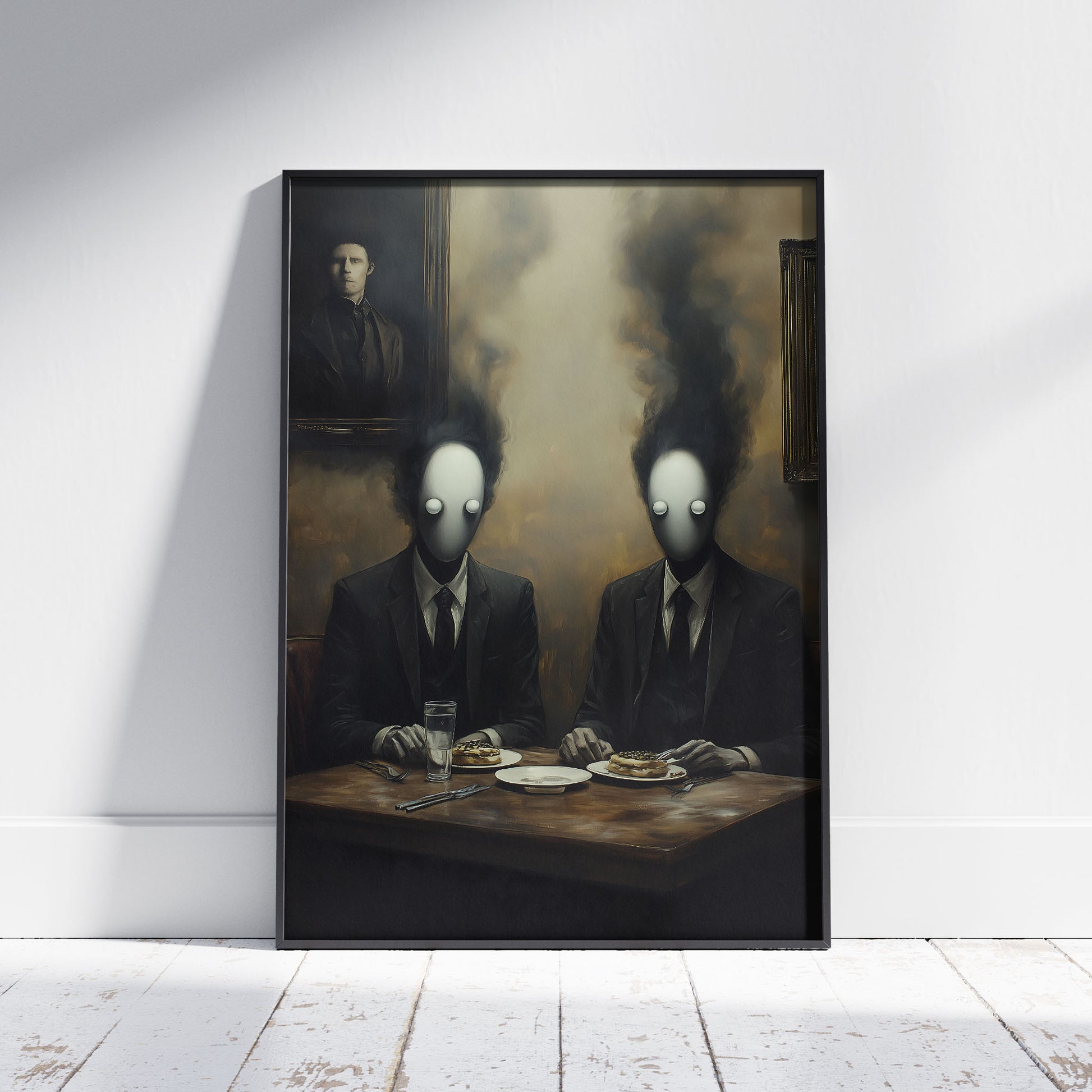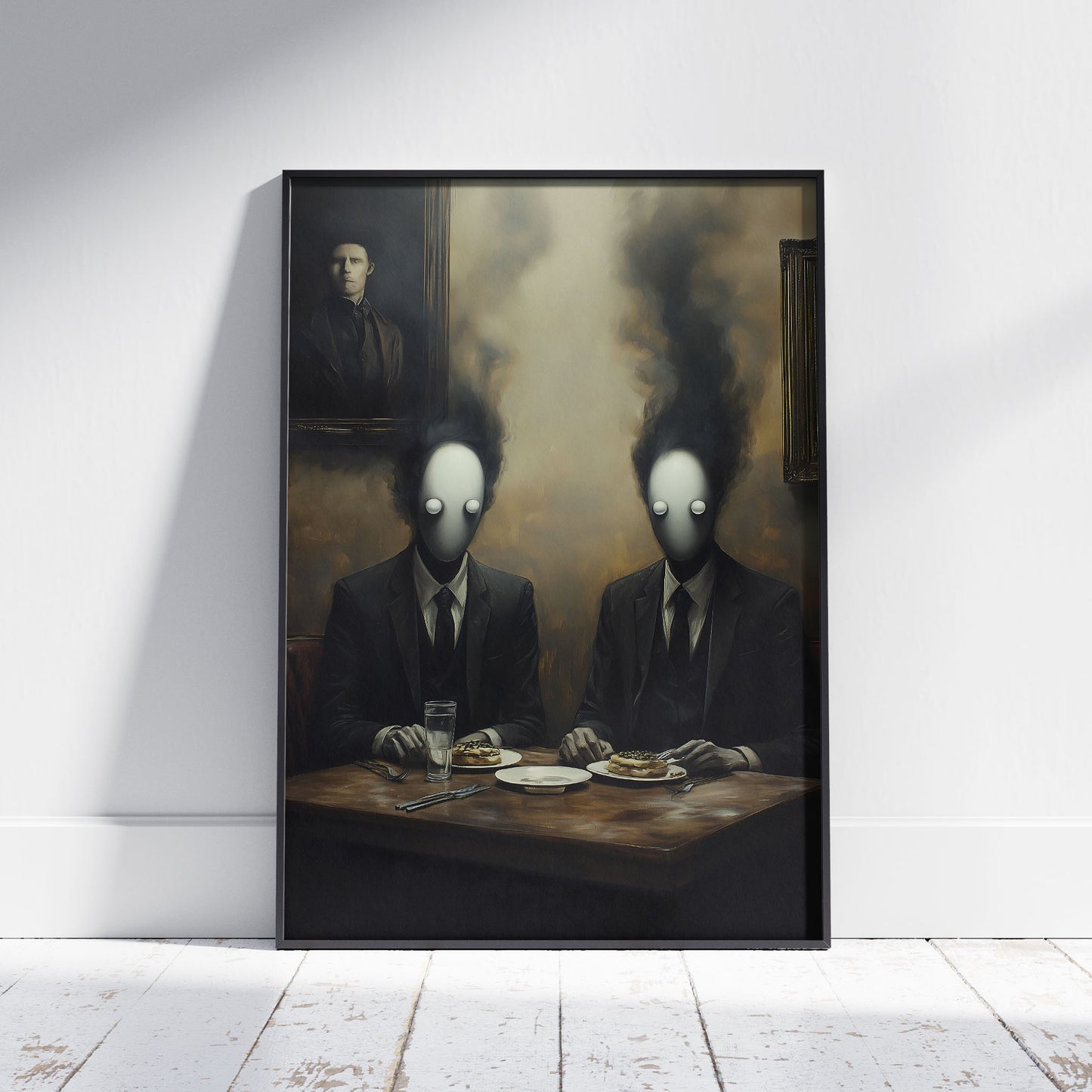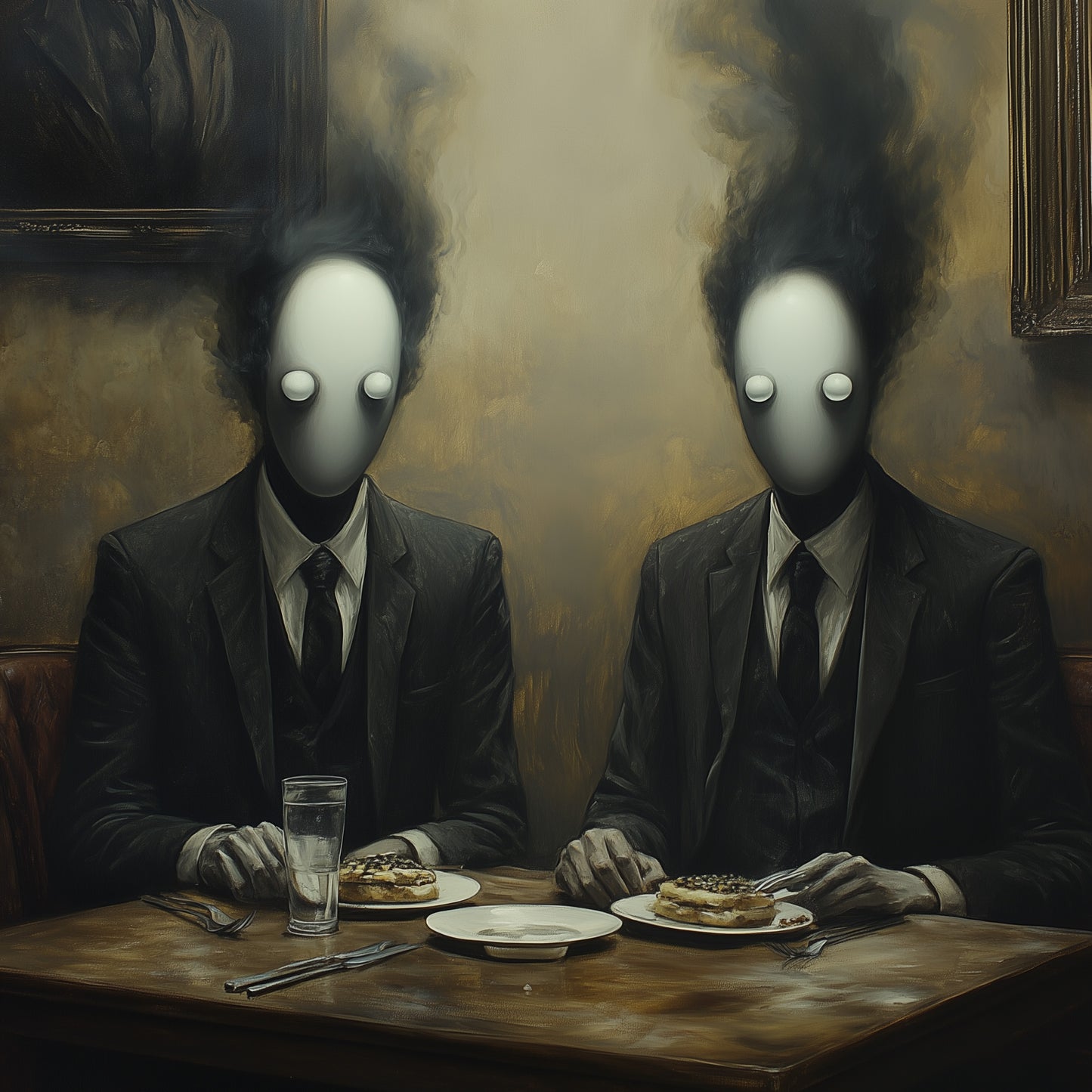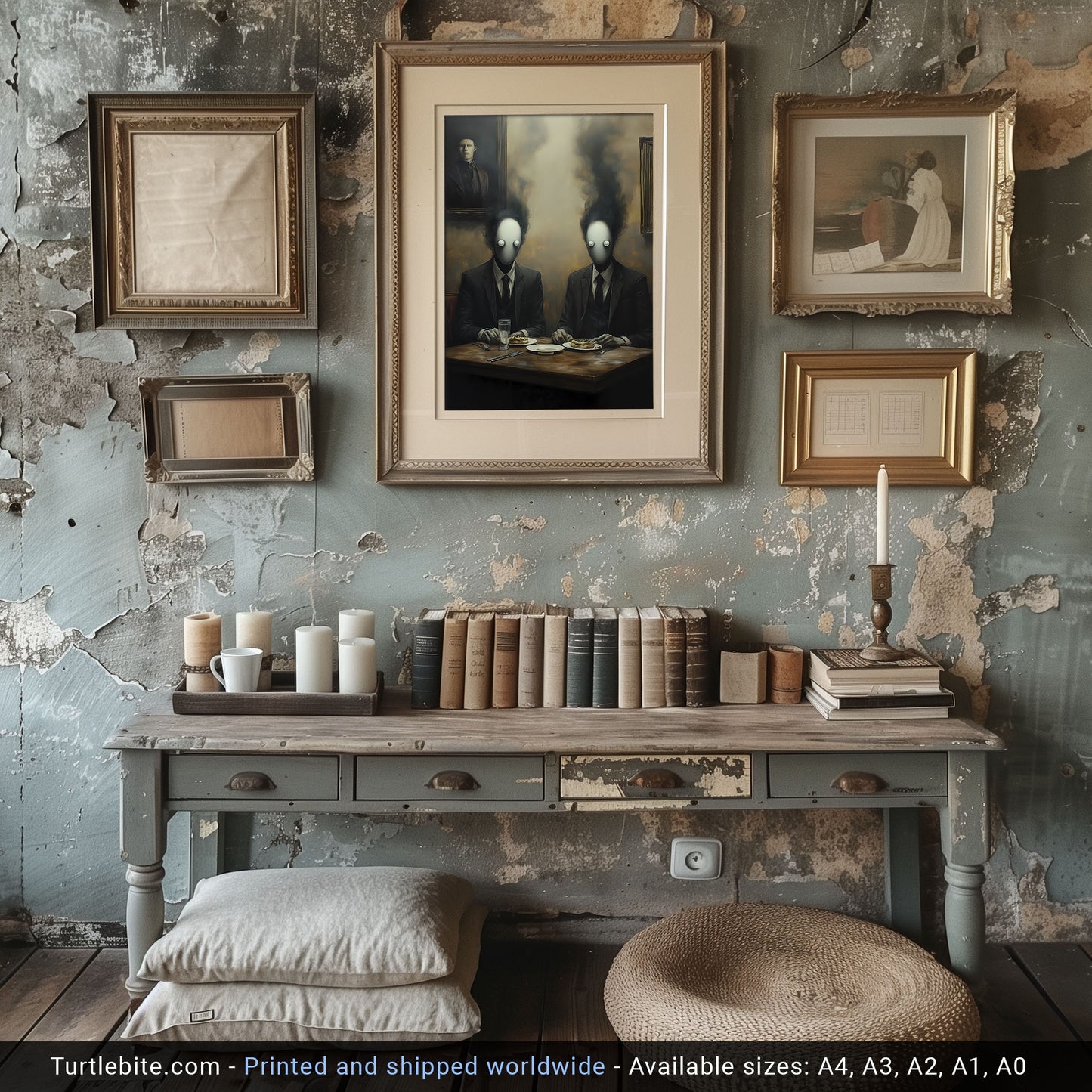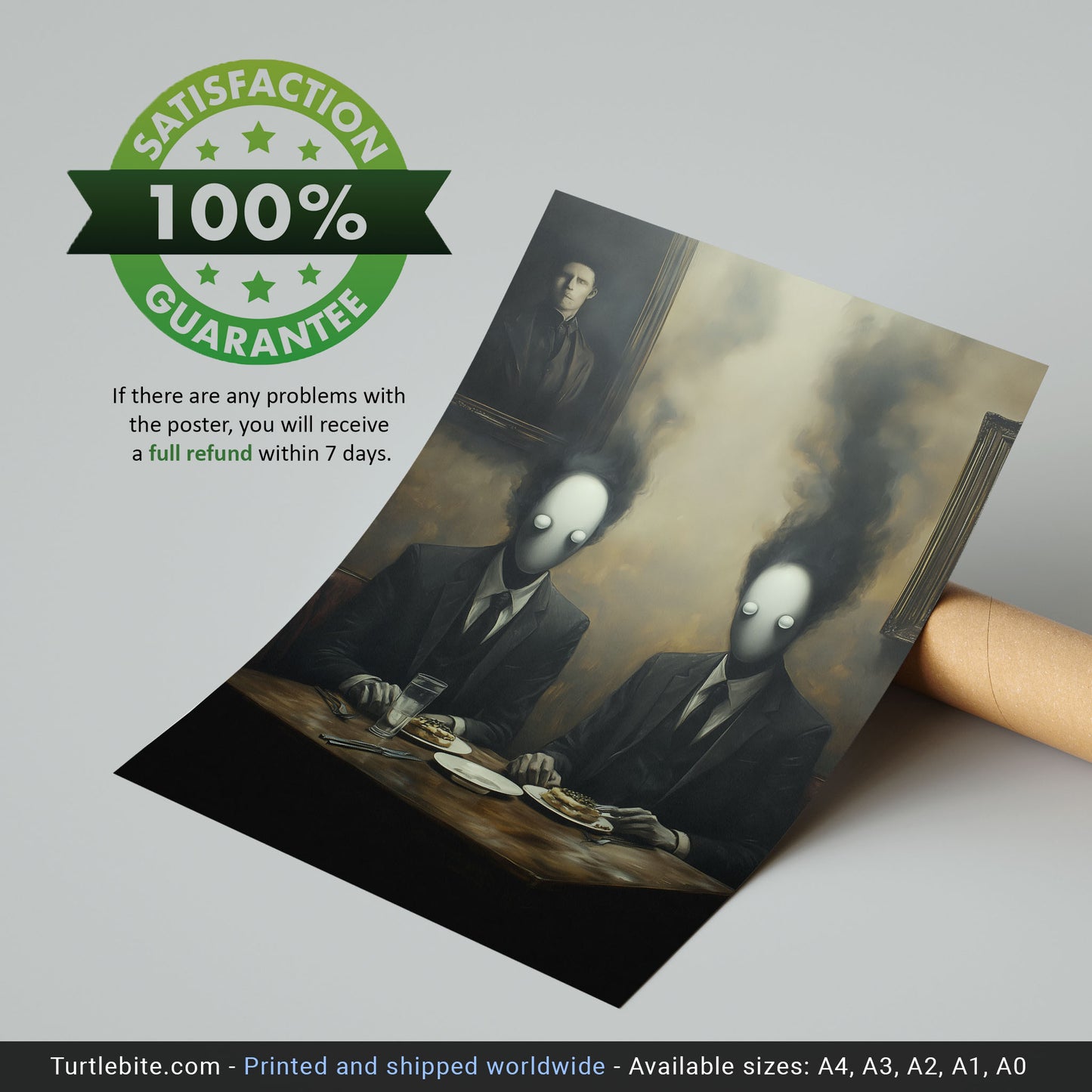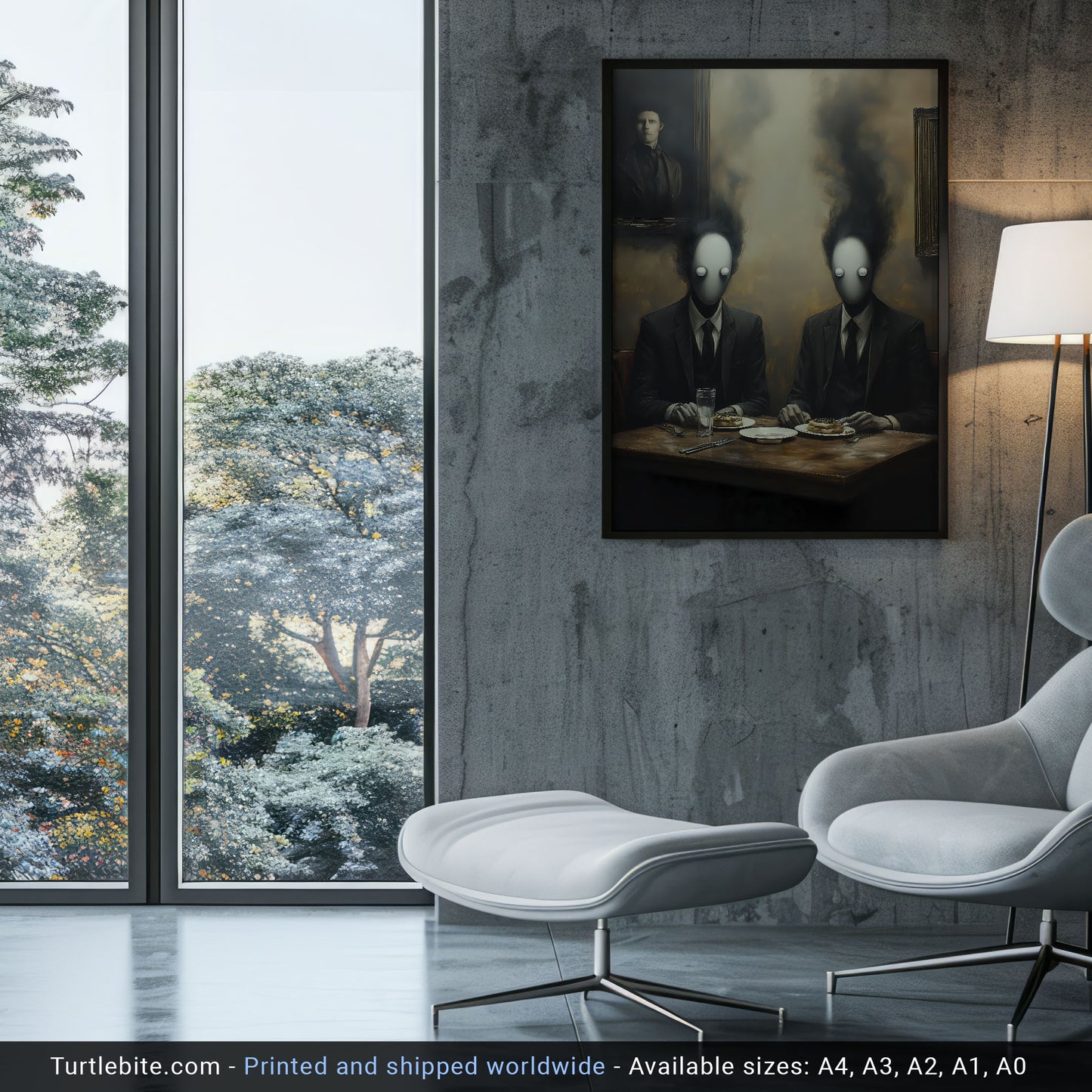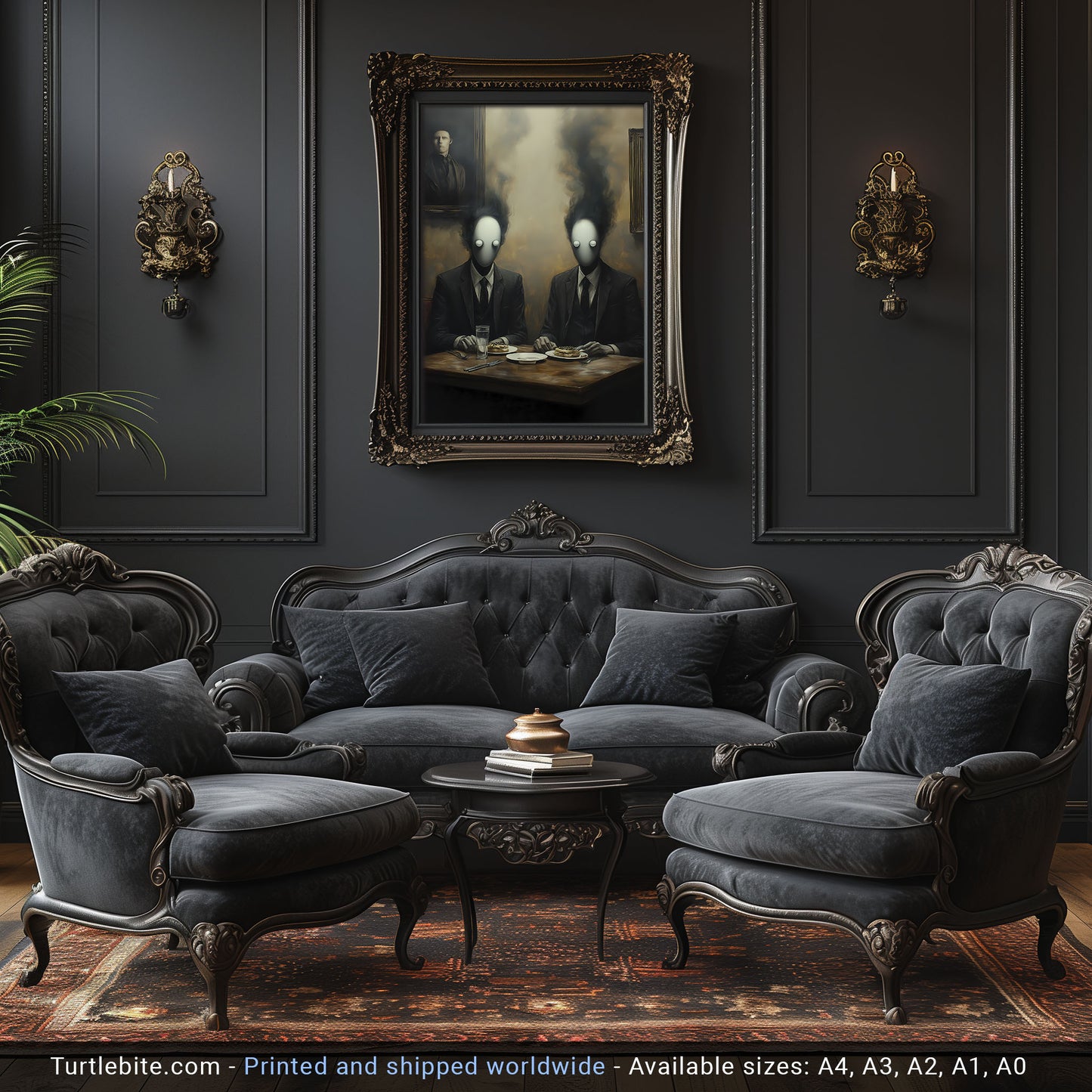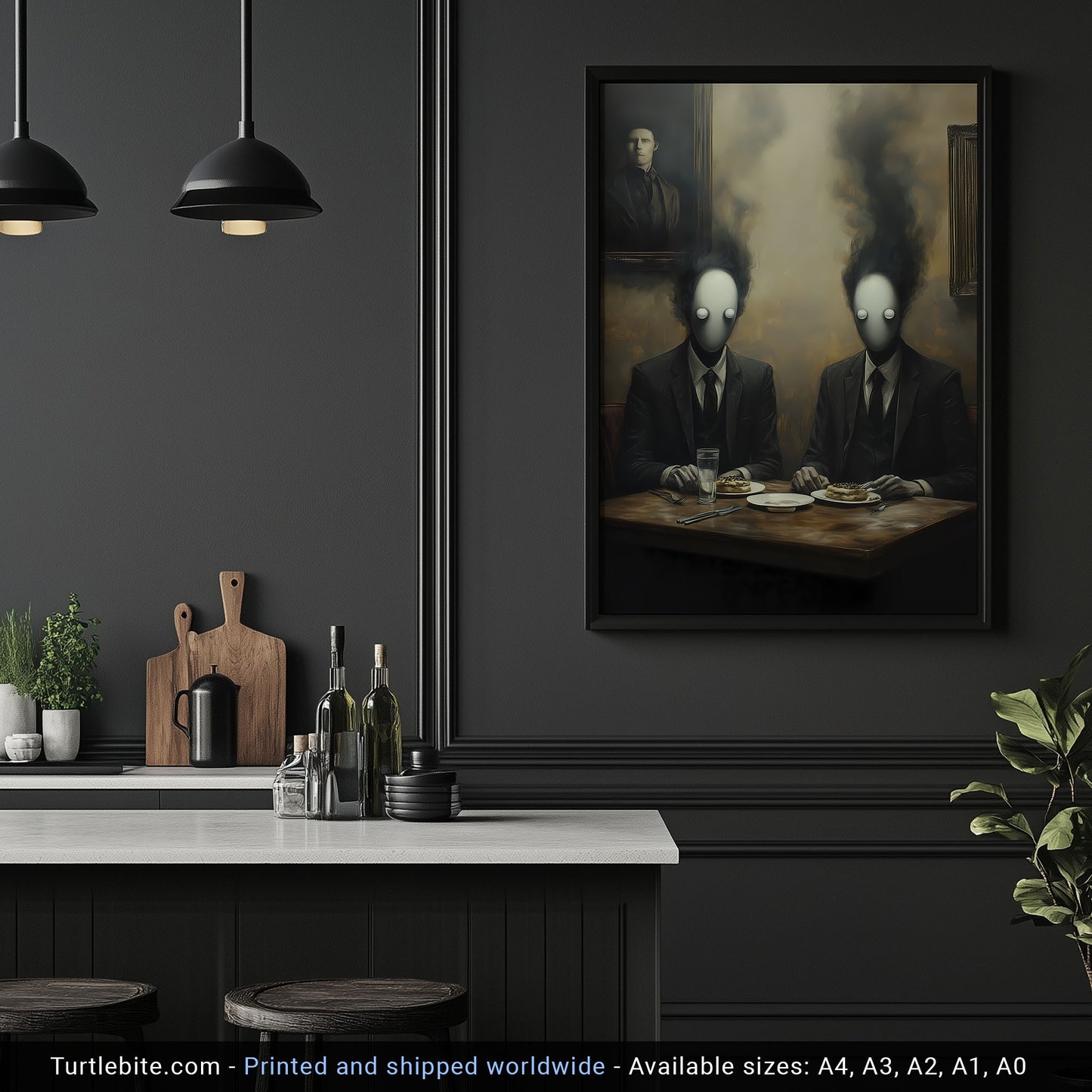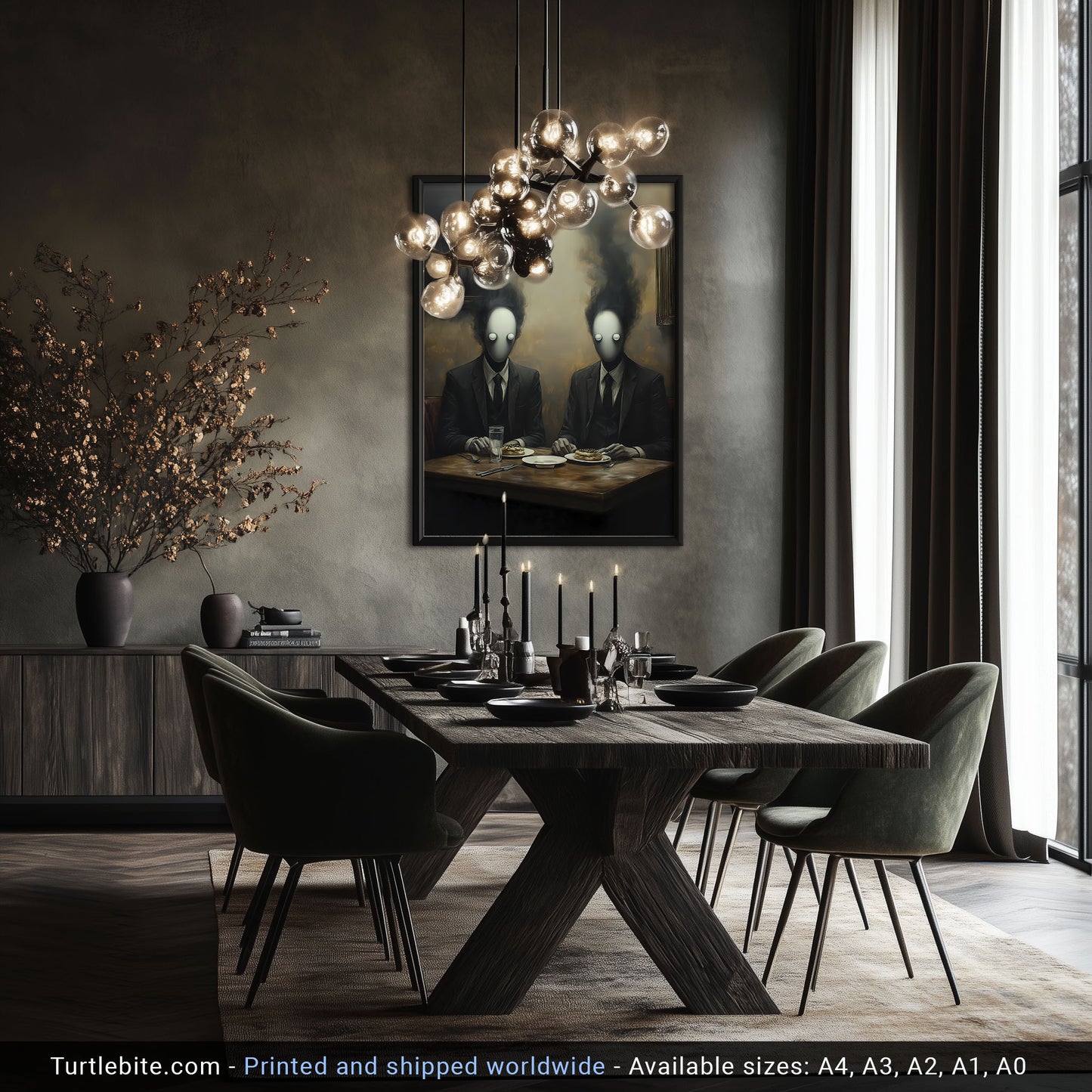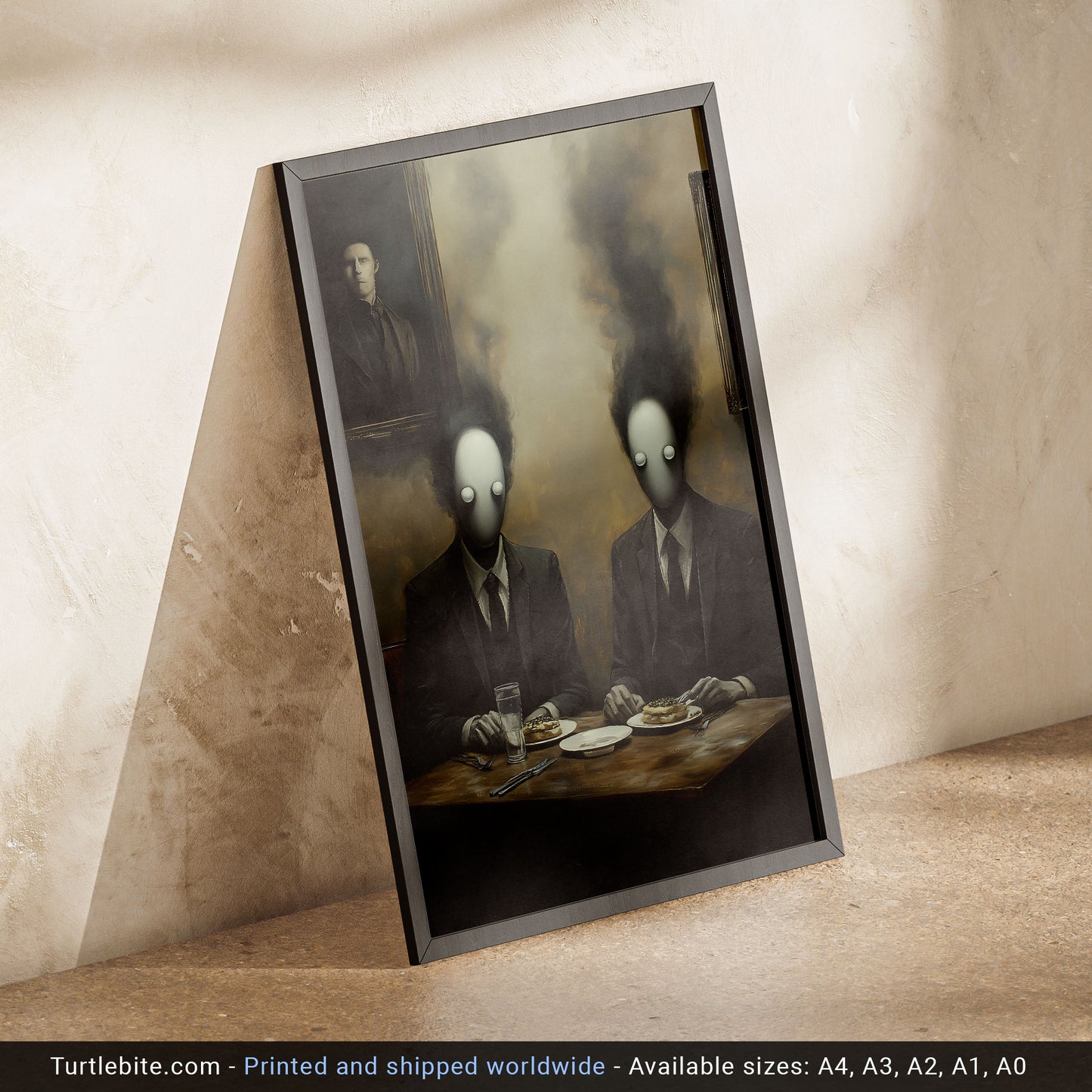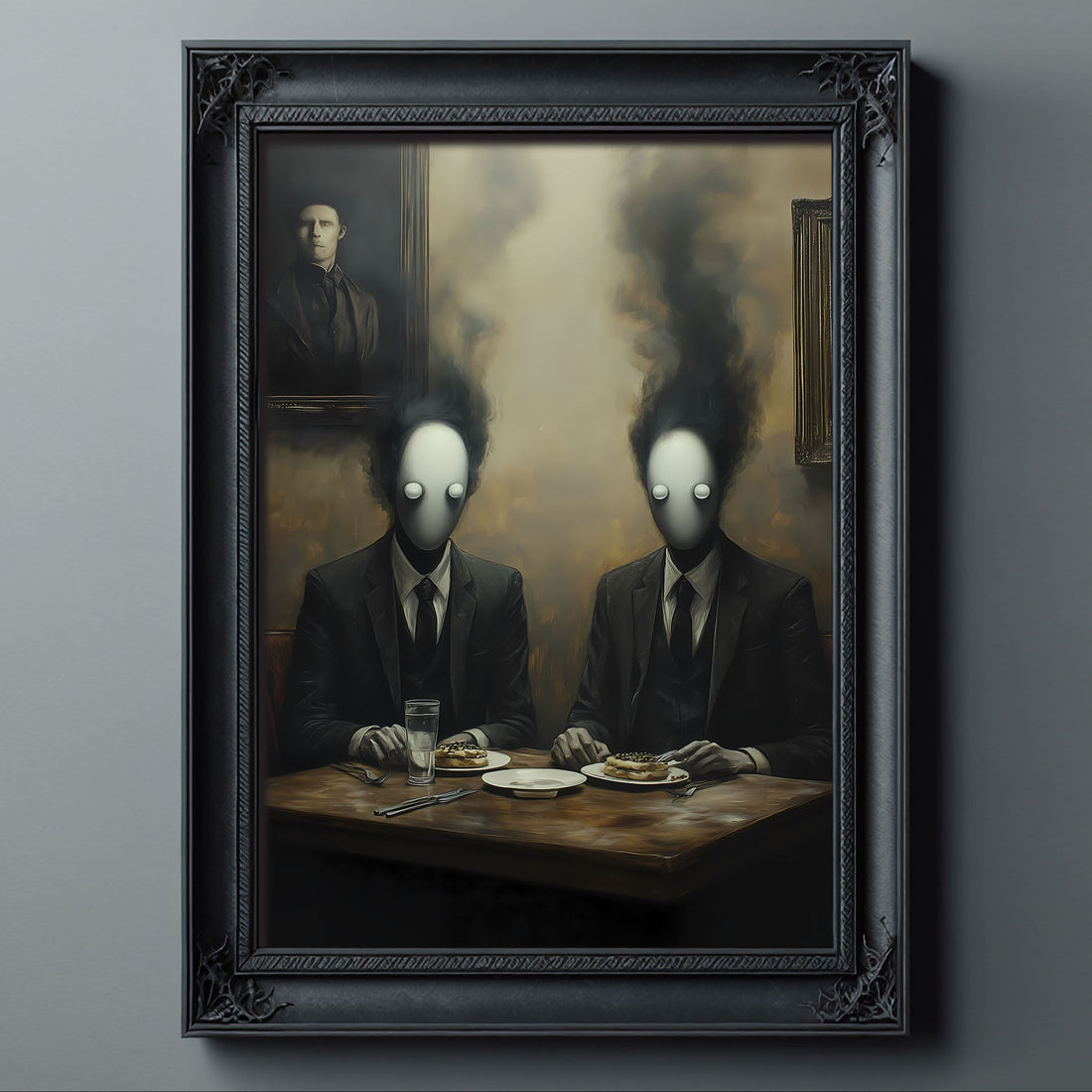
"Faceless Dinner" – A Surreal Descent into the Uncanny
ChristianShare
"Faceless Dinner" – A Surreal Descent into the Uncanny
In the world of surreal art, few images pierce the psyche quite like the haunting visual of two faceless men dining in eerie silence. The image titled "Faceless Dinner" invites viewers into a strange, unsettling universe - one that feels suspended between dream and nightmare. At first glance, it's an ordinary dining scene, yet everything from the ghostly figures to the heavy atmosphere suggests otherwise. This digital artwork fuses horror, surrealism, and psychological tension in a masterstroke of symbolism and aesthetic control.
This post will explore Faceless Dinner in detail - examining its composition, foreground and background elements, lighting, symbolism, and emotional weight. Whether you're a fan of surrealist aesthetics or looking to uncover hidden narratives in art, this analysis will help you unlock the unnerving genius of this unforgettable piece.
Composition & Scene Structure
The composition of Faceless Dinner is deceptively simple but remarkably effective. The primary focus lies on two suited figures seated at a small, polished wooden dining table. Their symmetrical posture immediately commands attention - both sit upright, facing the viewer, hands poised, creating a mirror-like effect that enhances the uncanny atmosphere.
Each figure is centered within their half of the frame, suggesting balance and duality. The painting within the painting - a portrait of a stern man behind the left figure - adds a layer of mise-en-abyme, subtly drawing a parallel between observer and observed.
The dining table acts as an anchor to the scene. Despite its conventional appearance - with two plates of pastries and a glass of water - the table's minimalism isolates the interaction. The absence of other diners, environmental sound, or movement gives the image a static, almost time-frozen quality. This calculated stillness contributes to the dreamlike dread the painting elicits.
The boundaries between background and foreground blur slightly thanks to the smoky diffusion that emanates from the figures' heads. This choice reinforces the image’s theme of identity erasure and psychological dissolution.
Style & Artistic Technique
Visually, the painting blends classical portraiture with digital surrealism. The meticulous rendering of the suits, table, and portrait background suggests traditional techniques, while the ghostly faces and smoky effects clearly point to modern digital art tools. This fusion is intentional - it juxtaposes realism with abstraction to enhance the viewer’s discomfort.
One of the most striking stylistic choices is the blank, reflective ovoid faces with two round eye-like impressions. These are not faces but placeholders - voids that seem to absorb light rather than reflect it. They resist interpretation and obliterate individuality, recalling the faceless archetypes in horror media or dreams.
The smoke rising from the heads is another powerful element. It’s rendered with a painterly texture that evokes oil or airbrushed charcoal, swirling upward into a hazy void that dominates the upper half of the composition. It may symbolize thoughts, lost memories, or the slow dissolution of identity.
Color plays a subtle but vital role here. The palette is mostly muted earth tones - sepia, brown, beige, and grey. This subdued range contributes to the piece’s antiquated, museum-like feel. The white of the faces sharply contrasts with the surrounding tones, making them pop unsettlingly.
The shadows and lighting are deliberately soft and diffused, enhancing the smokiness and flattening spatial depth. There's no harsh light source; instead, it feels like the entire room is illuminated by a single, ghostly ambient glow. This technique keeps the painting visually cohesive and dreamlike.
Foreground Details: Objects of Ordinary Dread
The foreground is a crucial player in this painting’s psychological narrative. The food - two pastries topped with what looks like chocolate or syrup - sits untouched, uneaten, and pristine. This suggests not nourishment, but ritual. Perhaps this dinner is ceremonial, symbolic, or entirely performative.
The fork and knife beside each plate are neatly placed, as if arranged for an interview rather than a meal. A single glass of water rests in front of the left figure, subtly creating asymmetry and leaving viewers to wonder: why only one drink?
These subtle divergences in symmetry - like the missing drink and the slightly different posture of the two figures - generate tension. They make the scene feel rehearsed but not perfect, like a dream on the verge of falling apart.
The hands of the figures are skeletal and pale, emphasizing an almost corpse-like quality. They're posed stiffly, as though unsure of what to do or waiting for an unseen signal. All these elements lend themselves to the surreal genre’s hallmark technique: using everyday objects to evoke existential unease.
Background & Psychological Symbolism
In the background, we find a portrait of a stern man gazing directly outward. This seemingly minor detail may be the key to the narrative. Is he the father of the faceless figures? Their creator? A former self? The contrast between his human features and their facelessness creates a haunting before-and-after dichotomy.
The wall behind the diners is partially obscured by the same fog or smoke that rises from their heads. The painting’s frame is singed and partially faded, as though time or memory itself is eroding the setting. This dreamlike environment, neither real nor fantasy, serves as a psychological limbo.
Symbolically, the faceless figures may represent the loss of self in modernity - suits and ties as the uniform of conformity. Their shared features and synchronized placement hint at the duality of man, or even the fractured self. Perhaps they are one person split into two, reflecting different facets of identity or consciousness.
The portrait implies an observer role - someone from the past who watches over this eerie ritual. Whether judgmental or indifferent, his gaze intensifies the discomfort, like being watched by the ghost of a former self. It roots the painting not only in surreal horror but in psychological introspection.
Emotional Tone & Interpretations
Faceless Dinner speaks to primal fears - loss of identity, isolation, and the disintegration of the self. There is no joy or connection in this meal, no conversation or expression. Instead, there's a haunting stillness, as if time is paused on the edge of something sinister.
The facelessness obliterates individual narrative. Who these figures are doesn’t matter - what matters is what they've lost. Their presentation in clean suits implies societal expectations, yet they are utterly dehumanized. This contrast may critique the soul-draining expectations of professionalism or conformity.
Alternatively, the figures could represent dissociation - mental fragmentation caused by trauma, routine, or existential dread. The smoky heads suggest thoughts escaping, dreams dissipating, or memory decay.
This painting could also be seen as a commentary on alienation. Two people sit close, sharing a meal, yet appear utterly isolated. There is no interaction, no emotion. Even in presence, they are absent.
The overall emotional impact is eerie, contemplative, and slightly terrifying. It provokes more questions than it answers - and in doing so, it succeeds as a piece of true surrealism.
Conclusion
Faceless Dinner is more than a surreal visual - it is an emotional and intellectual experience. Through stark imagery, symbolic detail, and masterful composition, it confronts viewers with themes of identity, conformity, and psychological erosion. The faceless figures, eerie stillness, and antique-like textures make this digital painting resonate with both modern anxieties and timeless existential dread.
Whether interpreted through the lens of psychological horror, dream analysis, or social critique, the painting leaves a lasting impression. It's an artwork that doesn’t shout but whispers - slowly drawing you into its foggy, faceless world.
In a culture increasingly drawn to surrealism as a means to process reality’s absurdities, Faceless Dinner feels not only timely but necessary. It reminds us that beneath the surface of civility and structure, something more fragile - and perhaps more frightening - lurks.

